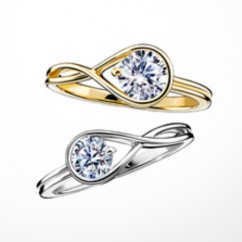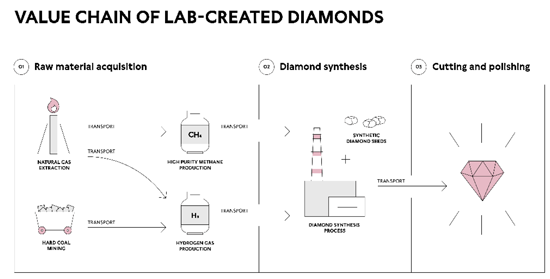Articles and News
Diamond Industry Blasts Pandora’s Positioning of Move to Lab Grown Only May 09, 2021 (2 comments)

New York, NY--The diamond and fine jewelry industry has quickly responded to Pandora's news last week that it was dropping natural diamonds and launching a new lab-grown diamond collection and positioning it as both affordable and sustainable. A release on May 7 from The Responsible Jewellery Council (RJC), the World Diamond Council (WDC), CIBJO, the World Jewellery Confederation, the Natural Diamond Council (NDC) and the International Diamond Manufacturers Association (IDMA) blasted Pandora for irresponsible statements.
The release, published in its entirety below, attacked Pandora's positioning of its business move as a "false and misleading" narrative that will potentially hurt many of the millions of people worldwide who earn their livings from the natural diamond industry.
Below the release are both Pandora's launch release as well as its sustainability positioning posted on its web site.
Some Background
It's well known that Pandora, the largest jewelry seller in the world by unit volume, sells inexpensive (mainly under $100 retail) jewelry to the masses.
So when the company announced that it will be forsaking mined diamonds for lab grown in its new Pandora Briliance collection, there was a lot of press coverage. The headlines from cbsnews.com, cnbc.com, italy24news.com, washingtonpost.com, theguardian.com, marketwatch.com, people.com, cnn.com and others mainly emphasized the drama of the company dropping mined diamonds and the "sustainability" of their new lab grown preference.
Most did not focus on the fact that Pandora Brilliance and its move to lab grown only is a business decision more than anything else. The company admitted in a Forbes.com article that prior to this move their sales of mined diamond jewelry amounted to about one tenth of one percent (.1%) of unit sales (50,000 pieces of mined diamond jewelry sold vs. 50,000,000 charms). Pandora believes they can grow their business with more affordable lab-grown diamonds and that lab-grown fits much better into the company's pricepoint wheelhouse.

The above process chart appears in Pandora's online statement regarding sustainability. Note that natural gas and coal are the fuels used to make diamond synthesis possible.
Pandora is marketing the Brilliance collection on a "sustainability" platform, admitting for the present that the process of making their lab grown diamonds uses "a large amount of electricity" and "carbon rich gas (e,g, methane)", both of which generally depend in large part on fossil fuels. For now they are offseting the significant use of fossil fuels and creation of "greenhouse gas emissions" via a "carbon finance project," in this case the support of a reforestation effort in the East African countries of Kenya and Uganda, under the auspices of Natural Capital Partners. This program works with thousands of farmers to plant trees (15 million to date) to replace those destroyed when farmers clear land for farming. But Pandora stated it does aim to make its lab grown diamonds with 100% renewable energy in another year (it claims 60% of the power it uses is renewalbe as of now).
Full Release from Diamond & Jewelry Associations
Industry Leaders Respond to Pandora’s Laboratory Grown Diamond Announcement
(May 7, 2021) New York: Leading jewellery industry organizations including The Responsible Jewellery Council (RJC), the World Diamond Council (WDC), CIBJO, the World Jewellery Confederation, the Natural Diamond Council (NDC) and the International Diamond Manufacturers Association (IDMA) have called on Pandora to market lab-grown diamonds (LGDs) responsibly and issue a public statement retracting the false and misleading narrative in their announcement on Tuesday, which positioned laboratory grown diamonds as an ethical choice versus natural diamonds.

The industry employs tens of millions of people around the world and their families and communities depend on the income and welfare that the natural diamond industry provides. These communities need the support of the industry now more than ever given the hardship brought on by the COVID-19 pandemic. The misleading narrative created by the Pandora announcement implying the natural diamond industry is both less ethical and the impetus behind Pandora’s move to lab-grown diamonds, particularly given the inconsequential amount of diamonds Pandora features in its collections, can have unintended but substantial consequences on communities in developing nations. The industry organizations have called upon Pandora to support communities by correcting the record.
The group acknowledges Pandora’s decision to sell laboratory grown diamonds as a positive expansion of the jewellery industry but warns that potentially false and misleading assertions can diminish consumer confidence across all categories and create confusion which is detrimental to the industry as a whole.
Pandora Brilliance Launch Release
Pandora launches lab-created diamond collection 05-04-2021
"Company aims to make diamond jewellery accessible to a wider audience. Launch marks a new milestone for Pandora as it will no longer be using mined diamonds."
Pandora today announced the launch of Pandora Brilliance, its first lab-created diamond collection. Aiming to transform the market for diamond jewellery with affordable, sustainably created products, Pandora Brilliance is initially introduced in the UK with global launch in other key markets expected in 2022.
Alexander Lacik, Pandora CEO, says: “Pandora continues its quest to make incredible jewellery available for more people and today I’m proud to announce the introduction of Pandora Brilliance. It’s a new collection of beautifully designed jewellery featuring lab-created diamonds. They are as much a symbol of innovation and progress as they are of enduring beauty and stand as a testament to our ongoing and ambitious sustainability agenda. Diamonds are not only forever, but for everyone.”
Consumer demand for lab-created diamonds
The diamond jewellery market is expected to continue to grow, and lab-created diamonds are outpacing the industry's overall growth. Lab-created diamonds are identical to mined diamonds but grown in a laboratory rather than excavated from a mine. They have the same optical, chemical, thermal and physical characteristics and are graded by the same standards known as the 4Cs – cut, colour, clarity and carat – before being set within the Pandora Brilliance collection.
The new collection includes rings, bangles, necklaces and earrings, each featuring a solitary lab-created diamond hand-set within sterling silver, solid 14K yellow gold or solid 14K white gold. Like other Pandora jewellery, the pieces can be collected and layered together, and the collection’s motif, a reimagined infinity symbol, is imbued with meaning. The concept is about infinite possibility – that the future is yours to shape – and the creative development is based on extensive consumer research in North America, Europe and China.
Certified carbon neutral
Pandora Brilliance has achieved CarbonNeutral® product certification in accordance with The CarbonNeutral Protocol, a leading global framework for carbon neutrality. The certification covers Pandora Brilliance jewellery, its packaging and transportation. The lab-created diamonds in the collection have been grown with more than 60% renewable energy on average, and greenhouse gas emissions from non-renewable energy are being offset through the CarbonNeutral certification. When Pandora launches the collection globally next year, the diamonds are expected to be made using 100% renewable energy.
Going forward, mined diamonds will no longer be used in Pandora’s products.
Pandora Brilliance is available to purchase from 6th May in the UK. The pieces are starting from £250 and each stone ranges from 0.15 to one carat.
Pandora's Details of Sustainability Positioning
The following now appears on the company's website:
Pandora Brilliance
Sustainably lab-created diamonds.
Our Pandora Brilliance collection features sustainably lab-created diamonds. These stones are physically, chemically, and optically identical to their mined counterparts but they are created above ground. They are a remarkable example of how innovation can replicate nature’s process and do so in a sustainable way.
Every diamond in the Pandora Brilliance collection is a sustainably lab-created diamond. This means that we know the origin of every diamond, that they have achieved CarbonNeutral® product certification in accordance with the CarbonNeutral Protocol, a leading global framework for carbon neutrality, and that they have been responsibly sourced in accordance with international human rights and labor standards.
To achieve CarbonNeutral® product certification for sustainably lab-created diamonds in the Pandora Brilliance collection, Pandora is working with a leading expert on carbon neutrality and climate finance, Natural Capital Partners. This means all greenhouse gas emissions associated with the creation of the Pandora Brilliance lab-created diamonds (Scopes 1, 2 and 3) have been calculated and subsequently offset by supporting a carbon finance project. To date, the lab-created diamonds in the Pandora Brilliance collection have been grown with more than 60% renewable energy on average. Next year, when Pandora launches the collection globally, the diamonds are expected to be made using 100% renewable energy.
In addition to achieving CarbonNeutral® product certification for the sustainably lab-created diamonds, Pandora has achieved CarbonNeutral® product certification for the full Pandora Brilliance collection including, for example the entire piece of Pandora Brilliance jewelry and its packaging.
The Pandora Responsible Sourcing Programme ensures that our suppliers and sub-suppliers adhere to our strict ethical, social, and environmental requirements. You can read about those policies here. This means that our lab-created diamonds have been made in accordance with international human rights and labor standards, and that suppliers adhere to industry good practice for environmental, health and safety management. To learn more about sustainably lab-created diamonds please see here.







